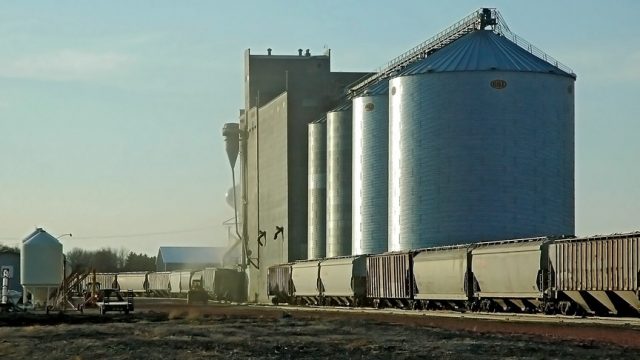Oil Pipelines Help Resolve Lack Of Rail Capacity For Farmers

Here’s some good news. After a couple of years of problems with farmers unable to put their crops on overcrowded rail lines it seems problems have eased, just in time for harvest:
Just in time for what the U.S. Agriculture Department expects to be near-record corn and soybean harvests, grain train cars are in abundance. The reversal is attributed to unprecedented spending on track upgrades, political pressure from politicians in agriculture-rich states and a drastic decrease in trains hauling crude and freight to and from the oil patch.
“There had been some uncertainties, but it has gradually gotten better,” said Josh Mardikian, grain manager at the South Central Grain Cooperative elevator in Sterling. As he spoke, a train was being loaded with 24 million pounds of spring wheat, much of which would be used for a national pizza chain’s dough. Grain trains had been running late by as much as 45 days in the past 18 months, Mardikian said, but in the past week, mile-long, 110-car trains had shown up some four days earlier than expected.
One might be tempted to suggest that the fall in oil prices since the beginning of the year is what’s caused this, but that’s not really the case. As I’ve pointed out previously, despite falling oil prices and rig counts North Dakota’s oil production has remained remarkably resilient and at near all-time record levels. This graph shows the most up-to-date numbers:
North Dakota is producing about as much oil as ever. The real relief has come from the fact that, despite the political obstruction of high-profile projects like the Keystone XL and Sandpiper lines, pipeline capacity is taking oil off the tracks. This chart from the North Dakota Pipeline Authority shows pipeline shipments of oil are now at parity with rail shipments:
“Justin Kringstad, director of the North Dakota Pipeline Authority, said in response to email questions the decline in rail volumes was in part because of the February start of the Double H pipeline, a project led by pipeline company Kinder Morgan,” reports UPI.
The Double H line is a 485 mile pipeline that runs from Dore, North Dakota, and can ship oil to refineries in Oklahoma. It has a capacity of up to 84,000 barrels per day and, as you can see, is already having a significant impact on how Bakken crude oil gets to market.
Now imagine what sort of impact the Keystone XL pipeline, which could take as much as 100,000 barrels per day of Bakken crude, or the Sandpiper line, which could take up to 225,000 barrels per day, would have on rail shipments of oil.
One major part of the political debate over oil pipelines which often gets overlooked is the side effects of not building pipelines. Not only does that push more oil to rail shipments, which are inherently more dangerous for the public, but it also crowds other commodities off the rails.
The propane shortage in the bitterly cold winter of 2014 wasn’t the result of America running low on propane but rather the inability to move propane, which is mostly shipped by rail, to where it was needed on overcrowded rail infrastructure.
Farmers faced the same problems. Rails full of oil shipments had less capacity for crop shipments.
That problem seems to be solved for now, no thanks to the political extremists who are trying to create an oil transport bottleneck by opposing pretty much anything that doesn’t result in the oil staying in the ground.






